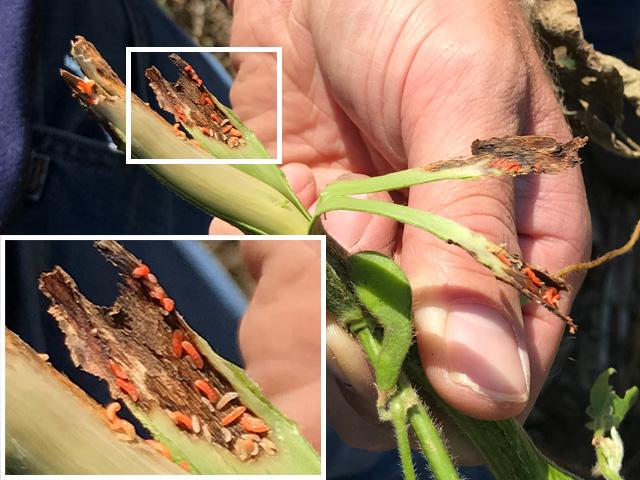First Soybean Gall Midge of 2024 Appear
Monitoring Network Sounds Alert as Soybean Gall Midge Trapped in Nebraska
JEFFERSON CITY, Mo. (DTN) -- Soybean growers who planted their beans in late April or early May should begin scouting for soybean gall midge. Researchers involved in a multi-state monitoring network sent out an alert May 31 that the pest has emerged at trapping sites in Saunders and Lancaster counties in east-central Nebraska.
"We found mostly adult males, but we did find two females in Saunders County on May 30," said Justin McMechan, crop protection and cropping systems specialist at the University of Nebraska. Last year, the first female was detected May 31 in the same county. "We expect to see the males first, but they don't infest plants."
Soybean gall midge is a tiny fly that lays its eggs on the stems of young soybeans plants. After the eggs hatch, the larvae feed on the tissues within the stem under the epidermis, disrupting nutrient and water movement. As they mature, the maggots turn from white to orange. Infested plants can quickly wilt and die or break off at the feeding site. Significant yield reductions may occur, especially at the field edge.
Plants are susceptible to infestation when they begin to develop small cracks or fissures on the stem at the base of the plant, typically at the V2 growth stage. These provide an entry point for females to lay eggs.
In a phone interview with DTN, McMechan said that this year, Nebraska enhanced its detection network. Soybean stems infested with gall midge from last season were buried 2 inches deep in the field. Cages were placed over these stem burial sites and monitored for the insect's emergence.
McMechan noted that some early-planted soybeans have already reached the V4 growth stage in Nebraska.
"Yes, they're still going to get a lot of gall midge, and there will be some yield losses, but the plants are probably going to stay alive fairly well," he said. "But if soybeans hit the V2 growth stage while gall midge is at peak emergence, that's a pretty deadly scenario for soybeans. They're the smallest they can be and they're susceptible."
P[L1] D[0x0] M[300x250] OOP[F] ADUNIT[] T[]
While planting soybeans early may allow the crop to overcome infestation, McMechan described the population carryover as "brutal."
"You maximize the population that will carry over the summer if you plant early," he said. "Late plantings can miss part of the emergence curve and can potentially lower populations for carryover for the next year. But even a June 1 planting will get infested at some point."
Though orange larvae were first observed in Nebraska in 2011, no specimens were collected or stored. It wasn't until 2018 that soybean gall midge was determined to be a new species that had not been documented. Since then, the Soybean Gall Midge Alert Network has documented the pest in 164 counties in seven states, including eight new counties in 2023.
As was the case last year, this year's initial emergence is slightly ahead of previous seasons. Once emergence begins, it typically continues for 25 to 35 days, though some overwintering sites have seen emergence last for 44 days. Once emergence occurs, white larvae are usually found in soybean stems within nine to 12 days.
MANAGEMENT TIPS
Management for soybean gall midge has been a hit-or-miss proposition. Chemical control has shown some results, but foliar-applied insecticides have been inconsistent between locations and years. McMechan previously told DTN that growers should only consider applying if they have a history of issues with soybean gall midge and observed the pest in an adjacent field the previous season.
He recommended using a combination product that contains a pyrethroid. A foliar treatment prior to the V2 growth stage isn't necessary because the plants have not developed the fissures or cracks at the base of the stem that provide the entry point for egg laying. Because soybean gall midge is a field edge-infesting pest, growers may only need to treat the first 60 to 120 feet of a field.
Infestation can also be controlled by covering the base of the soybean plants with soil. This "hilling" has been found to be a very effective strategy with almost complete control of soybean gall midge. However, the practice is difficult to implement when soybean plants are small, as they can easily be completely covered by soil.
SCOUTING TIPS
The following are some soybean gall midge scouting tips:
-- Scout edges of soybean fields adjacent to fields that were planted to soybeans the previous year, especially if they had a gall midge infestation.
-- Focus on fields that are V2 or older -- that's when the soybean stem starts to crack along the surface near the soil line. The adult midge lays eggs in these fissures.
-- Look for dark brown or black discoloration of the base of the stem. Scrape the exterior layer of the stem away to reveal larvae that start white and turn orange as they mature.
You can set up an alert notification of gall midge discovery here: https://soybeangallmidge.org/…
Jason Jenkins can be reached at jason.jenkins@dtn.com
Follow him on social platform X @JasonJenkinsDTN
(c) Copyright 2024 DTN, LLC. All rights reserved.






